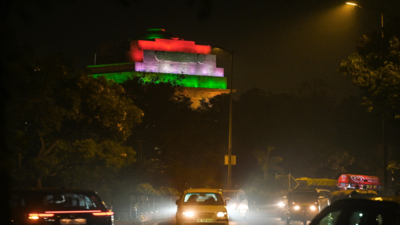- News
- City News
- faridabad News
- Delhi air quality: Day starts poor, ends poorer
Trending
Delhi air quality: Day starts poor, ends poorer
Delhi's air quality worsened throughout the day, moving from 'poor' to 'very poor' levels, with AQI peaking at 289 by 8 pm. Anand Vihar faced 'severe' air pollution initially. Contributions from stubble burning and neighboring regions significantly impact the pollution, with further deterioration expected.

In Anand Vihar, the AQI was in the 'severe' category at 421 at 12 pm but moved to the 'very poor' in the evening. The air quality in the city is predicted to deteriorate further.
Track the pollution level in your city
An AQI between 201-300 is considered poor, and that between 301-400 is considered very poor.


The average AQI of the city was 278 a day earlier. The main source of pollution was PM10 or the coarser particles.
The share of stubble burning in the city’s air pollution is likely to worsen over the next few days. According to the IITM’s Decision Support System (DSS), the share of stubble burning in the city’s air quality was 0.71% on Satur day, against 1.77% on Sunday. It is, however, projected to spike to 2.88% on Monday and 6.86% by Tuesday, respectively.
According to CPCB, on Friday, the PM2.5 levels oscillated between 112.5 to 111.2 micrograms per cubic metre, while the national standard for PM2.5 is 60 units, and the WHO has set the standards at 15 units for 24 hours.
The PM10 oscillated between 237.4 to 232.8 micrograms per cubic metre. The city on Sunday got some dry winds but that was not enough to improve the air quality to even moderate.
Among the major sources of pollution in the city was the influx of pollutants from neighbouring Gautam Budh Nagar, which contributed 11.3% to the city’s net PM2.5. This was followed by 9.69% from transportation, 8.25% from Ghaziabad, 7.7% from Bulandshahr, 2.6% from Delhi’s residential sector, 2.5% from Faridabad, 2.4% from the city’s and peripheral industries, 1.77% from stubble burning, and 1.27% from construction.
According to the air quality early warning system, the AQI could turn “very poor” by Monday. “The air quality is likely to be in the lower end of the very poor category from 21.10.2024 to 23.10.2024,” the warning system has forecasted. In the next 6 days meteorological conditions would be unfavourable for the effective dispersion of pollutants as calm winds will prevail during the night. Additional emissions from sources such as stubble/burning are likely to deteriorate the air quality significantly. “Controls implemented at pollution hotspots will have a positive impact on air quality," the system said.
Meanwhile, Gurgaon’s air quality deteriorated significantly on Sunday to the “poor” level (219) from the previous day’s “moderate” level of 176. The System of Air Quality and Weather Forecasting and Research (Safar) has predicted that weather conditions will be highly unfavourable for dispersion of pollutants starting from Oct 20.
End of Article
FOLLOW US ON SOCIAL MEDIA








